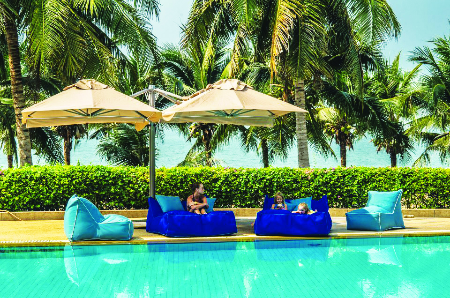If you're in the midst of designing your outdoor spaces - or if you've just come across our ideas on what to do with your urban garden space, and now find yourself wondering how to go about furnishing your outdoor sanctuary, then this is the guide for you. To help you find the right furniture, we studied a selection of outdoor spaces around the country and arrived at the following list of pointers to keep in mind when looking for your garden furniture.
Function As with any other space, consider the intended purpose of a space before setting out on your search for furniture. Whether your aim is to create a solitary seating lounge or an additional area for communal dining, the function of your outdoor space will help you to determine the kind of furnishings required. Also look to whether your outdoor space is dedicated or shared: a dedicated seating lounge will be able to host furnishings of greater weight and size, while a shared space containing both dining and seating areas may require discrete furnishings that can be moved or stacked in storage as needed.
Size Is your outdoor space wide or compact? A narrow outdoor space would not typically benefit from the placement of furnishings with hefty frames, often making for cramped quarters that contradict the expanse of the outdoors. A more balanced composition could be achieved in narrow outdoor spaces using furniture of sleek designs, with robust furnishings being more suited to wide and uninterrupted spaces.
 Image Credit: Les Asia
Image Credit: Les Asia
As we mentioned previously in our guide on selecting dining tables, there are rules-of-thumb that decorators use to achieve comfortable arrangements of furniture within a defined space. These guidelines suggest that the space typically required between dining furniture and walls would be around 900cm and 1.3 meters, while each seat should be afforded around 60cm to 70cm of space on both sides for adequate elbow room. This same guideline would be applicable for outdoor spaces surrounded by lush greenery, with greater distances afforded if the outdoor space comes with uninterrupted views.
 Interior design by: Zids Design
Interior design by: Zids Design
Material The consideration of the kind of material that your outdoor furniture should be composed of: wood, stone, metal, or plastic, is largely dependant on the style you want to affect, but it would be vital to keep in mind that the material choice will have an effect on the visual weight and longevity of your furniture.
 Interior design by: Sky Creation
Interior design by: Sky Creation
Outdoor furnishings composed of stone or wood are ideal for arrangements paying homage to traditional styles, but they tend to be bulkier in design, requiring more space as a result so as not to appear overly imposing. As we found with kitchen countertops: stone and wood materials are naturally porous, requiring specialised treatment and dedicated maintenance with sealing waxes or oils to keep their lustre.
 Interior design by: Latitude Design
Interior design by: Latitude Design
A greater variety of styles may be achieved with outdoor furnishings constructed out of metal or plastic due to their relatively higher strength - even in designs with narrow profiles. With the clear exception of wrought iron furniture, the tendency apparent in metal or plastic furnishings is a lean toward modern and minimalist designs, making metal and plastic furniture ideal for smaller outdoor spaces or for complementing contemporary interiors.
Click here to see some delectable outdoor arrangements.






Leave your comment